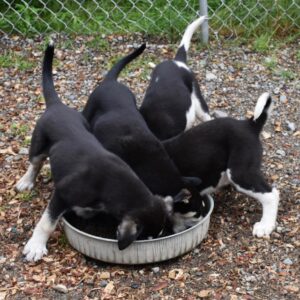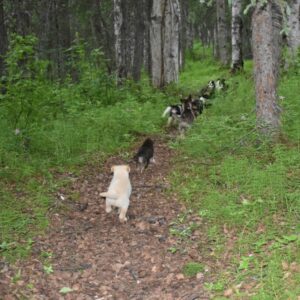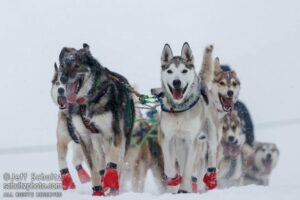Libby here! As I get close to being one whole year old, I’ve been remembering all the changes that have happened in my life so far. A lot of what I remember are the rhythms and routines of my puppy year.
The first rhythm I remember was my mother’s heartbeats. Thumpa thumpa thumpa! Our squirming pile of puppy-ness snuggled up against the coziest, warmest mama sled dog in the world Have you ever seen a puppy pile snuggled close to their mama? It’s the sweetest thing.
Soon, my puppy life became a soothing rhythm of snuggle, eat, sleep, snuggle, eat, sleep. As our puppy eyes began to open, we noticed the world around us, and we started to explore. The rhythm became eat, sleep, play, eat, sleep, play. And squeal. When we got hungry or tired or lonely, we squealed, and mom would come take care of us. Ah, that was the life!

The bigger we got, the bigger our world became, and the more rhythms we found around us. There still was play, sleep, eat, but everything was faster. Squirm became wiggle and bounce, and pitter-patter of puppy paws. We would chase chase chase around the puppy pen, then the puppy yard, then make a puppy pile and have another big nap.
Little by little, we started to notice the other big dogs. Besides Mom. They had their own rhythms of eat, sleep, and play. Instead of Mom, the mushers helped set the rhythm. Once, Mom explained to me that we would learn to trust the mushers because the mushers fit our rhythm. For sled dogs, the mushers start the day, bringing bowls of warm food and morning greetings. They help keep us clean, take us out to run, and make sure we have a safe and cozy place to sleep.
Day after day, when you can count on the rhythms, it’s easier to trust that you will be ok. The Mushers call it chores or “routines”, and they help create a predictable, reliable, and comforting rhythm of life. Mom says it’s super important for Iditarod sled dogs to trust that their mushers understand the rhythms. The mushers set the rhythm of running and eating and resting. If we run too long before resting, we won’t be able to keep up our running pace. When we stop to sleep, great mushers know how to quickly take care of our feet and our empty tummies so we can get a good long rest. When the musher’s routines fit our sled og rhythm, it’s a wonderful thing!
The mushers also figure out how to fit our sled dog rhythm to the rhythm of the seasons. When one Iditarod ends, preparing for the next one begins. Summer, when it’s too hot for the work of pulling, it’s time for free runs and relaxing in the sun. As days get shorter and colder, mushers start to put the sled dogs in harness again. The mushers don’t take us straight out to long runs. They set the rhythm, starting slowly and growing our strength and stamina (ability to keep going) to prepare for the time when the snow returns. Running. Resting. Eating. In a balanced rhythm. 
When I was old enough for free runs, I got to feel the rhythm of sled dog feet. Bumbling and tumbling down a muddy trail was a bit wild at first, but soon we were loping like the Big Dogs. There’s something spectacular about running alongside your best friends with a thumpa thumpa of paws in your ears and in your heart. When I got to run alongside the team on fall practice runs, the thumpa thumpa became a whole symphony of rhythms, from a pad-pad-pad walk, to a trot-trot-trot, to a thrumming lope. Mom says there is nothing so thrilling as being hooked in harness with your team, all running together, creating one deep rhythm across the snowy wilderness.

As we slide into the seasonal rhythm of spring, summer, fall, winter, I end my puppy year and begin the next verse of my sleddog life. I will play and eat and sleep and run. I will dream of the first snowfall, hooked in with my team, experiencing the rhythm of the trail.
What are the rhythms in your life? What is the rhythm of your day, the rhythm of the seasons? What routines help you keep the rhythm? How do they help you feel safe?


